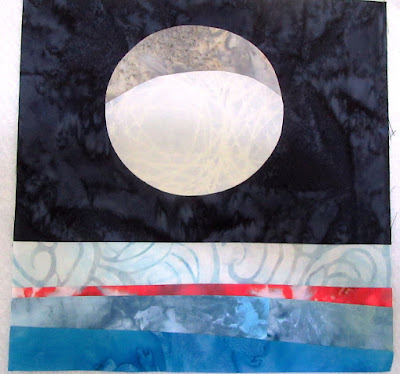These blocks measure 17" and will be trimmed down before they get sewn together. I'm using fusible web for the pieces appliqued to the background squares. Following the manufacturers directions for each of the fusible products I am mentioning here with mixed results. As you can imagine, this uses a lot of product. I've already used up all my Steam A Seam 2 adhesive, which I said before was a nightmare to work with. The only advantage is that it's tacky and can be repositioned if you need to move a piece around before fusing. This product leaves a sticky gummy mess not only on your needle when stitching down, but also behind the applique. What will this do to the fabric in the long run? Or, maybe it will wash away....eventually.
In the picture shown above, I have removed the background behind the piece so that there is no show through on the front and as you can see, there is a lot of residue.
After running out of the Steam A Seam 2, I searched my drawers and found some Heat N Bond Lite. This product is a better choice as it is not as sticky and gummy and pieces can be removed by making a slight scoring on the reverse side of the layers and place a bone tool between to gently un-stick the piece. Stitching down is also easier but your needle will gum up a bit. I always keep cotton pads and rubbing alcohol near by to clean off my needle when necessary.
The large circle was showing through the small circle, so I cut away the background and larger circle so that there is only 1 layer of applique in the center instead of 3 and no more show through.
The interfacing product I am using is a fusible interfacing called Totally Stable which is cut the size of the block and ironed on the reverse of the block to prevent any tunneling while blanket stitching the edges of applique. This is easily torn away after all stitching is complete, but can leave some tiny bits behind. You can choose to remove all the tiny bits with tweezers, which to me is very tedious and boring or just leave them. They'll be buried between batting and stitched with quilting on top, so they don't have anywhere to go. And they are tiny. My choice is to leave them.
It's slow going, but I only have 5 more blocks to make until I can trim them all up and start the next phase which is sewing them together. Have a great sewing day. :o)


















.jpg)